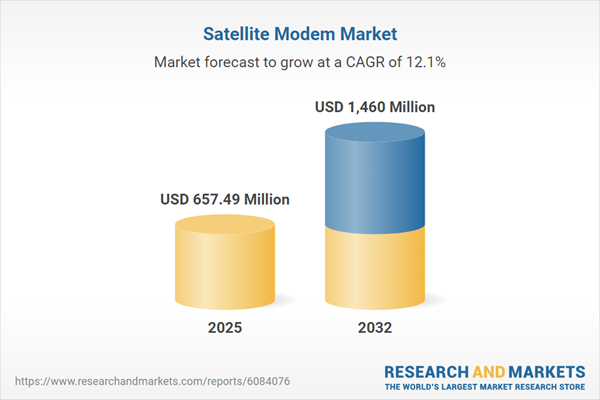Speak directly to the analyst to clarify any post sales queries you may have.
The satellite modem market is rapidly transforming as organizations worldwide seek dependable, high-performance connectivity for mission-critical operations in challenging and remote environments. With rising reliance on real-time data, evolving network architectures, and new applications across sectors, satellite modems have become pivotal to modern enterprise infrastructure strategies.
Market Snapshot: Satellite Modem Market Size and Growth Trajectory
The satellite modem market grew from USD 586.29 million in 2024 to USD 657.49 million in 2025. It is projected to sustain a CAGR of 12.11%, reaching USD 1.46 billion by 2032. This robust growth is propelled by ongoing advancements in modem efficiency, heightened connectivity requirements, and increasing adoption of satellite communications across diverse industries and geographic regions.
Scope & Segmentation
This comprehensive report segments the global satellite modem market across key parameters, providing actionable insights on critical business dimensions:
- Component Type: Hardware, Services
- Product Type: Indoor, Outdoor
- Application: Commercial, Government, Military
- Technology: BGAN, IoT (Broadband, Narrowband), VSAT (Ka Band, Ku Band)
- Data Rate: High, Medium, Low
- Frequency Band: C Band, Ka Band, Ku Band
- Regional Coverage: Americas (North America – United States, Canada, Mexico; Latin America – Brazil, Argentina, Chile, Colombia, Peru) Europe, Middle East & Africa (Europe – United Kingdom, Germany, France, Russia, Italy, Spain, Netherlands, Sweden, Poland, Switzerland; Middle East – United Arab Emirates, Saudi Arabia, Qatar, Turkey, Israel; Africa – South Africa, Nigeria, Egypt, Kenya) Asia-Pacific (China, India, Japan, Australia, South Korea, Indonesia, Thailand, Malaysia, Singapore, Taiwan)
- Key Players: Hughes Network Systems, LLC; Viasat, Inc.; Comtech Telecommunications Corp.; Gilat Satellite Networks Ltd.; ST Engineering iDirect Inc.; Advantech Wireless Technologies Inc.; Al Yah Satellite Communication Company PJSC; Bharat Electronics Limited; Datum Systems Inc.; EchoStar Corporation
Key Takeaways
- Satellite modem demand is rising as connectivity extends to remote sites, maritime, and mobile operations where terrestrial alternatives are limited.
- Integration of software-defined features and multi-band support enables modems to adapt to diverse usage scenarios and regulatory requirements, optimizing performance and lifecycle value.
- Technological breakthroughs in semiconductor design and signal processing empower reliable real-time communications for Internet of Things endpoints in demanding environments.
- Market players are innovating with energy efficiency, resilience, and embedded security to address the needs of critical infrastructure and regulatory compliance.
- The competitive landscape is shaped by strategic alliances, ecosystem partnerships, and value-added service offerings, including real-time analytics and managed connectivity.
- Growing regional adoption reflects differences in economic development, regulatory frameworks, and infrastructure investments – from North American maritime commerce to Africa’s digital education initiatives.
Tariff Impact
Recent United States tariffs on electronic components have influenced the global satellite modem supply chain. Manufacturers are revising sourcing strategies, developing alternative chipsets, and broadening production bases to mitigate rising costs and supply delays. Service providers are renegotiating contracts and collaborating on localized manufacturing to maintain business continuity for key sectors, such as government and defense. These adjustments foster long-term resilience and adaptability across the satellite communications value chain.
Methodology & Data Sources
This research applies a multi-pronged methodology, drawing on primary interviews with industry executives, system architects, and regulatory experts, as well as comprehensive secondary analysis from validated industry reports and government filings. Advanced statistical methods reinforce qualitative insights, ensuring the report’s findings are robust and actionable.
Why This Report Matters
- Gain an informed view of technology and regulatory shifts influencing satellite modem deployment strategies worldwide.
- Identify emerging business opportunities in high-growth regions and applications.
- Benchmark strategic direction against leading players and evolving service models to inform long-term investment decisions.
Conclusion
The satellite modem market’s ongoing evolution is defining next-generation connectivity for enterprises operating beyond terrestrial network limits. Stakeholders equipped with current insights can navigate market complexities and leverage the newest innovations for sustainable competitive advantage.
Table of Contents
3. Executive Summary
4. Market Overview
7. Cumulative Impact of Artificial Intelligence 2025
List of Figures
Samples

LOADING...
Companies Mentioned
The key companies profiled in this Satellite Modem market report include:- Hughes Network Systems, LLC
- Viasat, Inc.
- Comtech Telecommunications Corp.
- Gilat Satellite Networks Ltd.
- ST Engineering iDirect Inc.
- Advantech Wireless Technologies Inc.
- Al Yah Satellite Communication Company PJSC
- Bharat Electronics Limited
- Datum Systems Inc.
- EchoStar Corporation
Table Information
| Report Attribute | Details |
|---|---|
| No. of Pages | 199 |
| Published | October 2025 |
| Forecast Period | 2025 - 2032 |
| Estimated Market Value ( USD | $ 657.49 Million |
| Forecasted Market Value ( USD | $ 1460 Million |
| Compound Annual Growth Rate | 12.1% |
| Regions Covered | Global |
| No. of Companies Mentioned | 11 |









